In the ever-evolving landscape of Korean personal care, health, and beauty products, KM Pharmaceutical stands as a testament to adaptability and innovation. Over its two-decade journey, the company has successfully transitioned from its origins as a manufacturer of Pororo personal care products to becoming a prominent player in the OEM/ODM sector, collaborating with global brands. Brian Baik, the CEO of KM Pharmaceutical, shares insights into the company's history, its response to challenges posed by the COVID-19 pandemic, and its ambitious plans for the future. From the success of Pororo to the pursuit of excellence in oral care manufacturing, KM Pharmaceutical's story unfolds at the intersection of quality, innovation, and a commitment to environmental sustainability.
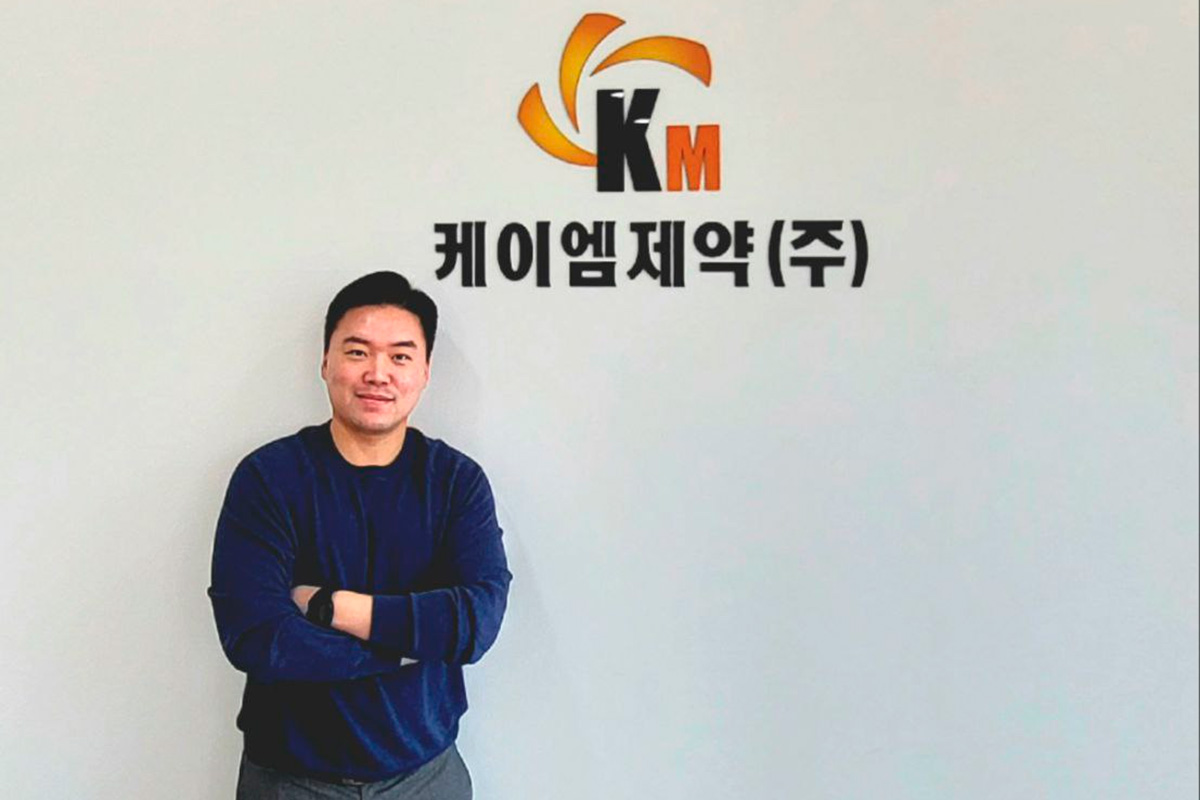
Korean personal care, health, and beauty products have experienced incredible growth over the past five years. In contrast, Korean brands in Western markets face the challenge of aligning with customer expectations and competing against well-established historical brands. How do K-beauty products distinguish themselves from international competitors, such as J-beauty (Japanese beauty) and French brands? Additionally, how significant is it for Korean companies to expand into new markets?
I believe that the primary advantage of Korean products lies in their quality, which I consider to be of utmost importance. Simultaneously, Korean products are known for their affordability. In the past, lower-priced products often came with lower quality. However, consumers have become increasingly informed, with access to a wealth of information. For instance, in the past, many people blindly purchased major brand’s products, but now consumers scrutinize ingredients and explore alternative cost-efficient brands. With this increased transparency, Korean companies have placed a strong emphasis on ensuring product quality. In fact, our company is dedicated to rigorous quality control. Therefore, I would argue that quality is the most significant advantage that sets us apart from other manufacturers worldwide.
Furthermore, I believe that the success of "Made in Korea" products can be attributed to our geographical proximity to markets that demand affordable yet high-quality products. European countries and the U.S. have historically been accustomed to high-quality items, whereas we are situated close to Southeast Asian countries and China, which previously had limited purchasing power. This strategic location has played a pivotal role in our expansion within these markets.
KM Pharmaceutical was founded in 2001. Over the past two decades, you've forged strong ties within the Korean market through distribution in major department stores and online platforms such as Lotte and Coupang, in addition to launching a microbiological testing laboratory in 2014. Could you provide an overview of your company's journey through its history? Also, what challenges do you anticipate your company may encounter in its path towards future growth?
The company's inception dates back to 2001 when our chairman (Il Mo Kang), ventured into pharmaceuticals with the goal of creating a toothpaste. With prior background and experience in working with toothpaste, he started out in his garage to fulfill his goals. Along his venture, he had a strategic approach in establishing a connection with the intellectual property owner of "Pororo, the little penguin", a renowned Korean animated character beloved by toddlers and children. Interestingly, no one was manufacturing Pororo personal care products at the time, not even the company that owned Pororo. Thus, he secured a licensing agreement with them, and we became the exclusive licensee for Pororo personal care products worldwide. This marked a significant turning point for our company. Pororo enjoyed immense popularity in Korea, akin to Mickey Mouse, though not on the same scale globally. It was a stroke of luck to have the privilege of using the Pororo character, and this became our initial growth phase.
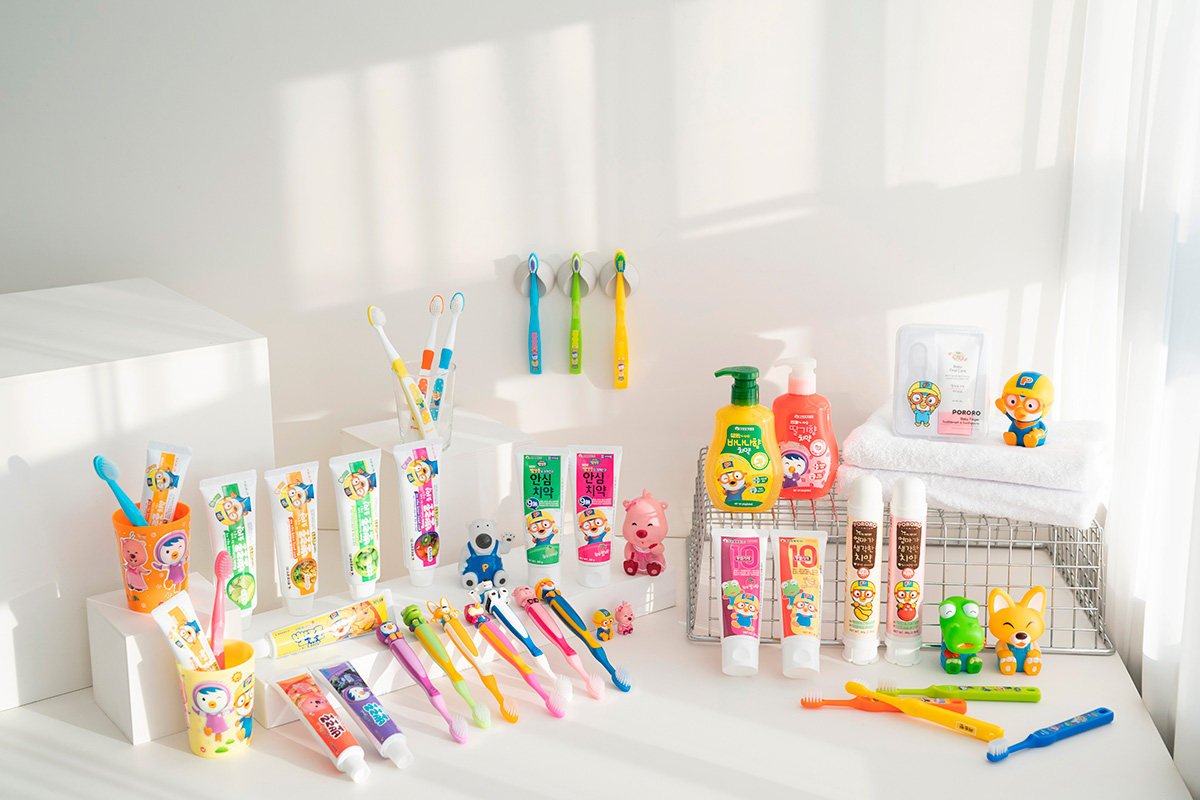
Pororo personal care products
Subsequently, our chairman expanded into the adult sector, particularly adult toothpaste, and introduced our first proprietary brand, "Jit." We ventured into B2B distribution, notably in the military sector, which yielded substantial results.
Our ambition extended beyond toothpaste; we branched into cosmetics. To facilitate this expansion, we established the Research and Development (R&D) center and became increasingly involved in Original Equipment Manufacturer (OEM) and Original Design Manufacturer (ODM) businesses. This shift led us to pivot away from our own brands and focus on OEM contracts, which has been a defining aspect of our journey. It is through these contracts that we were fortunate enough to work with globally renown brands, such as Closeup (USA), Lebon (FR), Coupang (KR), and more. However, our progress was interrupted by the onset of the COVID-19 pandemic.
The COVID-19 crisis brought about interesting developments for cosmetics and personal care brands. Color cosmetics notably suffered due to lockdown measures, as people were unable to go out. In contrast, skincare products, personal care items, and quasi-drugs like hand sanitizers and masks experienced significant growth. A notable challenge arising from this was the rise of online channels, altering marketing strategies and ushering in numerous new market entrants. Some of these companies lacked manufacturing capabilities, and instead, they outsourced production and branded products directly for sale to consumers. In this dynamic landscape, how did your company navigate this period, leveraging the growth in the personal care market while also adapting to new competitors? What strategic changes did you implement during the COVID-19 pandemic?
When COVID-19 hit, we were fortunate because we were already engaged in manufacturing. In Korea, manufacturing toothpaste, for instance, necessitates a license, which our facility holds, due to its classification as a quasi-drug. This same principle applies to the manufacturing of hand sanitizers, given their quasi-drug status. To be honest, did anybody have a specific strategy in place when the pandemic struck? The COVID-19 pandemic did impact us significantly, particularly in terms of our export operations. However, our advantage lay in our ability to swiftly transition our production lines to meet the surging demand for hand sanitizers. This adjustment played a pivotal role in offsetting the losses incurred from reduced exports. This agility is how we managed to endure.
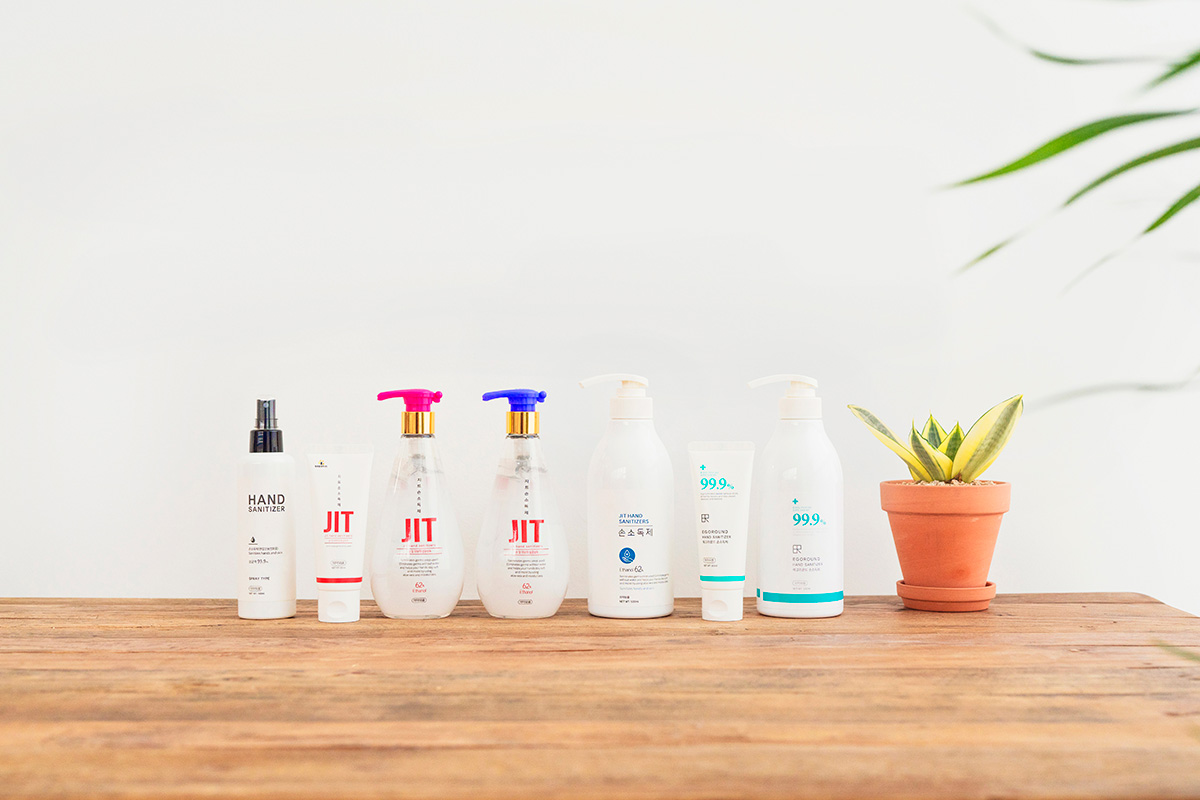
Various hand sanitizers manufactured during the COVID-19 pandemic to meet market demands
In summary, our immediate strategy was to pivot into hand sanitizer production, which effectively compensated for our export-related setbacks.
Your company initially utilized the Pororo brand for kids' products and later expanded into adult products. During the COVID-19 pandemic, you introduced additional products to sustain your business. What do you envision as the future portfolio of your company?
I believe this is where my role comes into play. From my perspective, our chairman had reached a growth plateau. While Pororo had experienced substantial growth in the past, it had plateaued in recent years, possibly even experiencing a slight decline. We found ourselves lacking the next product that could propel our company to the next level, especially considering our strong presence in the OEM and ODM sector. We already have significant domestic and international customers in this domain.
Our company went public in 2018. The onset of the pandemic marked the first time we posted negative growth for two consecutive years. When I first joined the company, I had the privilege of engaging in a profound and insightful conversation with our esteemed chairman. This discussion delved into the intricacies of the company's future trajectory and the strategic plans for expansion. While he desired continued expansion, he had become accustomed to the previous business model. My approach has been to refocus on our core strengths. KM Pharmaceutical originally began as a manufacturer of oral hygiene products. As we expanded with Pororo products, we ventured into various sectors such as skincare and shampoo. However, I believe our fundamental competitive edge lies within the oral care sector.
In the competitive landscape of the Korean oral care sector, where manufacturing giants like LG, Kolmar, and AK dominate, our aim is to position ourselves among these industry leaders. These companies not only provide OEM and ODM services but also concentrate on developing their own brands. Beyond these giants, there are mid-sized and smaller manufacturers. My strategy involves positioning our company to compete alongside these giants in the oral care sector. We plan to concentrate more resources on acquiring OEM/ODM customers within the oral care sector, shifting emphasis from the cosmetics sector. However, this strategic shift doesn't signify abandoning cosmetics; rather, it signifies a transition from OEM/ODM services to the development of our own branded products in the cosmetics sector. Ultimately, my vision entails cultivating two distinct and substantial business portfolios for our future. Furthermore, within the realm of our proprietary products, manufacturing in-house is not obligatory; we have the flexibility to outsource. This encapsulates the forward-thinking vision guiding our company's strategic direction.
How do you envision the evolution of your business portfolio concerning your international connections? Where do you anticipate experiencing the most growth?
When we examine our oral care business, historically, we didn't actively target international markets. In other words, we didn't proactively seek out customers overseas. For instance, in the case of the brand Lebon, a French brand, we were fortunate enough to manufacture their products in Korea because we had an intermediary. This intermediary, who is our customer in Korea, introduced us to Lebon, establishing that connection. Several international brands have come our way through intermediaries in a similar manner. However, we are now taking steps to engage with clients directly. I personally make an effort to attend numerous global conventions and industry events. Additionally, we're leveraging the support provided by government institutions like KOTRA and KITA, which offer export-related assistance. We're making proactive efforts to reach out to international customers independently.
When considering the international market, which regions do you believe are the most critical or possess the highest growth potential for your business?
It's a bit different from the traditional market entry strategy. We're not aiming to enter those markets directly. Instead, our focus is on attracting clients from those markets. These brands are already selling their products in both Korea and the Southeast Asian region, but our goal is to be the manufacturer of their products. Currently, these brands produce their items in their own countries, or possibly in China or Vietnam. In essence, our objective is not market penetration; it's about enticing them to have their products manufactured at our production facility. We aim to provide that service.
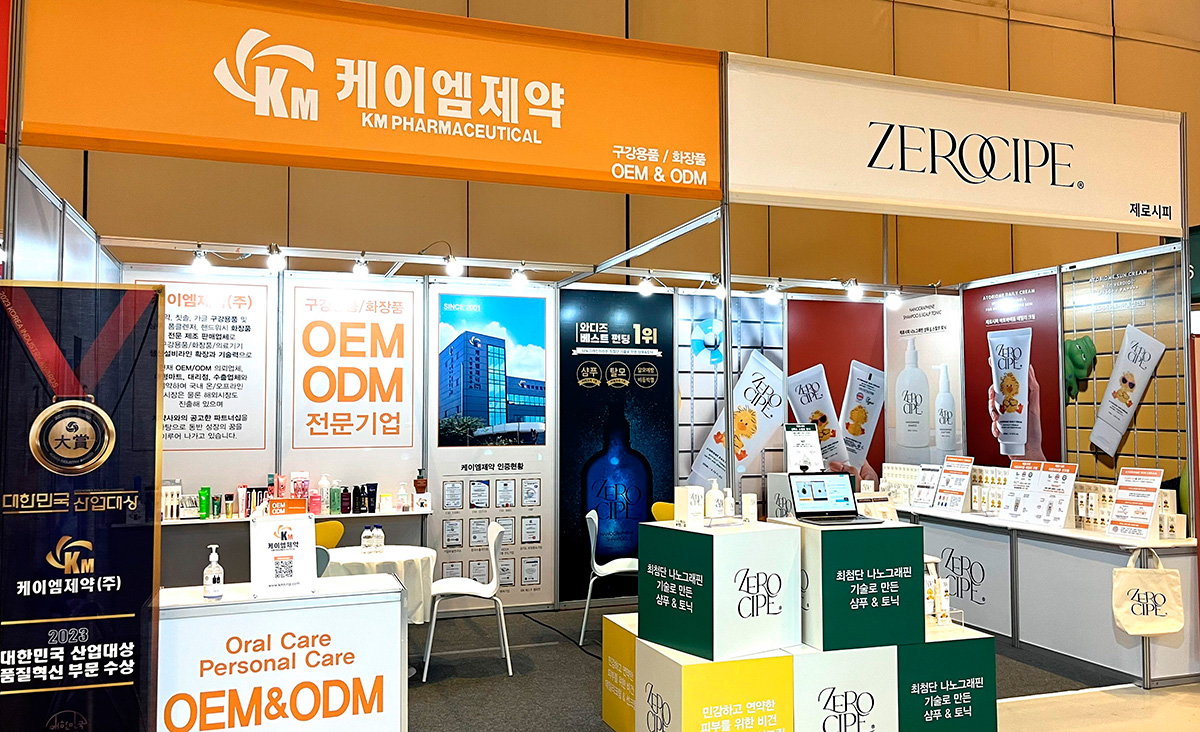
KM Pharmaceutical and Zerocipe (KM Pharmaceutical’s cosmetic brand) Booth @ InterCharm Korea 2023
What types of brands are you aiming to work with? Is there a specific region that you believe is more receptive to these types of services?
Initially, our primary target is our own country, South Korea. Here, we already have some of the best-selling global toothpaste brands, specifically the high-end ones, not the lower-priced alternatives. The reason these products are expensive is due to their use of high-quality ingredients, and, in addition, these products are typically manufactured overseas. Our objective is to bring the production of these global items to our facility, with the aim of contributing to cost reduction.
If you aim to engage with these brands already selling in Korea but manufacturing in China, you can entice them through your quality processes, perhaps by using similar ingredients but with enhanced traceability, a crucial factor. Alternatively, you might offer improved packaging. Being an OEM company, you also have the potential to develop new products in the future. On this note, what are your advantages compared to other OEM/ODM manufacturers or even foreign OEM/ODM entities?
While the core ingredients in a given toothpaste are largely similar, our approach involves seeking out companies that produce unique, seldom-used ingredients. We identify these companies and endeavor to secure contracts with them. With these special ingredients, we work on developing our own toothpaste formulations, putting them to the test. If the results are favorable, we proceed to production. Recently, we signed an MOU for an exclusive agreement with a company that pioneered nanographene, a form of graphene oxide created at a 13-nanometer scale. To the best of my knowledge, they were the world's first to achieve this. We were also the first to incorporate nanographene into a cosmetic product—specifically, our recently launched shampoo and scalp tonic. This marked the first instance of nanographene in a market-ready product. While we do pursue exclusivity with other partners, nanographene represents a breakthrough that has come to fruition. In summary, we actively seek raw material and special ingredient partners with the aim of creating innovative products.
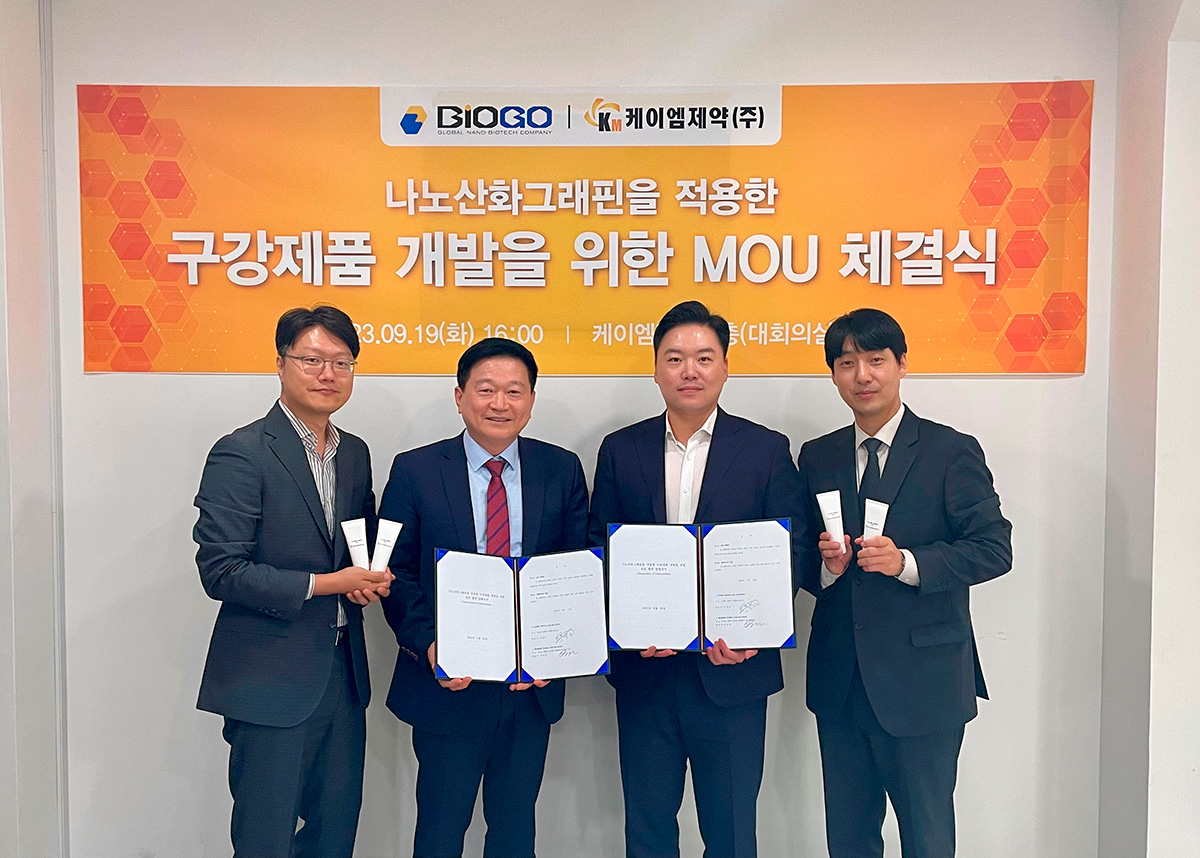
MOU singing between BIOGO (now INBCT) and KM Pharmaceutical for nanographene. From left: Dr. Soon Won Choi (CTO of BIOGO), Dr. Jaechul Ryu (CEO of BIOGO), Brian Baik (CEO of KM Pharmaceutical), Dr. JongYoon Jung (R&D Director of KM Pharmaceutical)
When we look at the Asian market, whether in cosmetics or food, there's a prevalent discussion about natural products derived from plants, like ginseng. What is your stance on this type of ingredient?
I believe the approach differs for skincare and oral care. Many traditional Korean herbs and materials have already been extensively utilized and are readily available in the market. Their popularity has already had its time, and I don't anticipate a resurgence. As a result, we are not currently focused on these traditional ingredients. Instead, our attention is directed towards exploring newer, innovative ingredients.
When collaborating with your customers on R&D, to what extent can you engage in product development, and what kind of engineering support can you offer when creating new products for them?
When we embark on the development of a new product for our customers, we integrate the customer's source materials or technology with our own manufacturing capabilities. For instance, in the case of products incorporating nanographene, we collaborate with the company that possesses the source technology. In terms of R&D, we communicate our strategies and narratives with our partners to collectively innovate and develop new products as an Original Design Manufacturer (ODM).
Our strategy is primarily centered on partnership and collaboration rather than isolation. We acknowledge that we don't have the resources or scale to go at it alone. Instead, we prefer cooperative efforts with other partners. We inform our clients about the collaborations we've engaged in, sharing details about the technologies involved from both parties and how they contributed to the creation of their product. This transparency allows the client to incorporate this collaborative effort into their marketing narrative.
Nowadays, consumers are becoming increasingly conscious of environmental and health-related aspects. The traceability of products and materials in the personal care sector is high on the list of many consumers' priorities, along with a significant emphasis on eco-friendliness. How is your company responding to these twin trends of traceability and sustainability? What assurances do you provide, and how do you adapt your services?
We are committed to minimizing the negative impact on the environment during the development and production of our products. Our approach involves utilizing byproducts from nature. For instance, we explore the use of materials like cornhusks or tangerine peels in the creation of new cosmetic products. Moreover, when it comes to packaging, aside from the commonly used eco-friendly packaging materials, we are actively seeking to incorporate packaging materials made from abandoned rocks, for which we have secured a patent for the technology. This underscores our commitment to promoting eco-friendliness. The core principle here is to safeguard the environment and make the most of natural materials that occur organically.

Patented eco-friendly mineral paper packaging. Patent number : 10-2021-0093936
One of the common challenges, particularly when you have a diverse client base as an OEM/ODM provider, is the concern companies have about the possibility that you might leverage their technology to create your own brand, thereby becoming a potential competitor in the market. Your company has an extensive track record in OEM/ODM, as well as a history of developing your own brands. How do you assure your clients that their trade secrets will be respected and that you won't become a competitor in the future?
It's important to recognize that we produce hundreds and thousands of products, each with its unique advantages and drawbacks. Moreover, the development approach for each product is distinct. Our fundamental business model is rooted in never proposing or introducing identical products to different clients. This principle has been key to KM Pharmaceutical's success in the market over the past two decades. To date, there hasn't been a single instance where our clients complained or raised such concerns. This illustrates why there are numerous researchers in the OEM/ODM industry. We tailor our products to meet the specific needs of each client.
On the flip side, let's consider a scenario where we develop an exceptional product for a client. However, there's always the risk that this client might take the product to a different manufacturer. To mitigate this risk, as mentioned above, we actively seek ingredients that can be used exclusively by us. We prevent them from sourcing these ingredients elsewhere. This strategy does not only protect our products, but also gives us a competitive edge at the same time. Looking ahead, I aim to apply the same approach, even in the skincare sector. For instance, with something like nanographene, I would not allow exclusivity to be compromised.
Do you have a specific overarching ambition or goal that you've set for yourself, something you aspire to achieve during your tenure?
As mentioned earlier, my goal during my tenure here is to grow and become one of the named oral care manufacturing giants here in South Korea. I believe this is highly attainable given the array of projects we are currently engaged in.
Before joining this company, I dedicated a decade to SK Innovation, where my expertise primarily centered around business development. During my tenure, I actively contributed to strategic initiatives and gained invaluable experience in the intricacies of organizational growth. Upon assuming my current role here, I shifted my focus from the traditional business aspects to prioritizing the reinforcement of the company's internal stability. My emphasis lay in cultivating a robust foundation that ensures the stability and resilience necessary for our future endeavors. I am confident in my ability to identify and bring together the right individuals, orchestrating their efforts harmoniously to propel this company to the forefront of the oral care sector in Korea.
0 COMMENTS